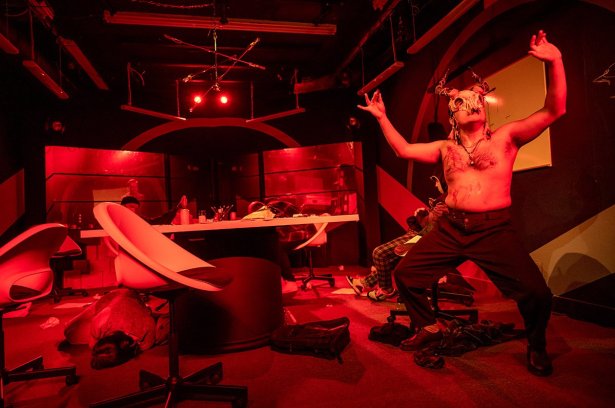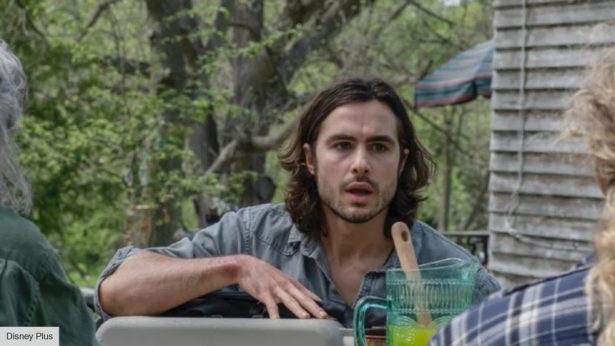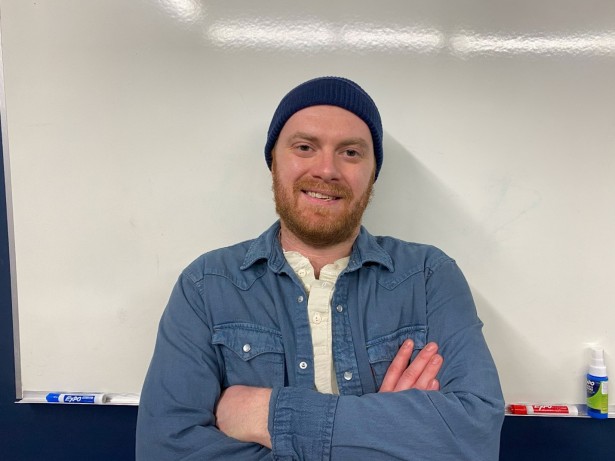10 November 2023: We held a Green Tease at The Stove Network in Dumfries exploring landownership, land justice and the role of culture.
The evening started with a shared community meal, giving attendees space to talk and get to know each other. Maja Rimer, our culture/SHIFT officer, introduced Creative Carbon Scotland’s work and highlighted that the climate crisis is a cultural issue.
Richard Bracken, Highland-based artist and maker, presented his work with The Abriachan Forest Trust. Artists and Community Landowners is a collaborative project, working with the community to tell the story of their landownership journey through a series of handmade walking sticks. The sticks represent a connection between the hand and the land, an object held by an individual that can be passed on to others, along with local knowledge and insight.
Richard passed the engraved walking sticks around the room, allowing people to get familiar with them before setting off on an artistic walk in Dumfries, through the town centre, by the river Nith and back to The Stove. People were encouraged to write a short response, reflection or dedication from the walk, and attach these to a walking stick that was left at The Stove as an artefact of the event.
‘…it was interesting to see how the sticks could function as objects for prompting different communities to talk about themselves and their possible futures. I did feel that walking with this particular collection of sticks helped to give the walk a purpose beyond simply reaching a destination. Some of the discussions I had with people while we walked were to do with connecting to land and local landmarks on a personal level, while others spoke of their involvement in existing community groups and focus on the climate crisis.’
Richard Bracken
John Wheeler, one of our panellists, felt that the active, artistic approach engaged the attendees, including the younger generations:
‘We all know something of the power of the staff – in stories from the Old Testament to Gandalf’s Middle Earth. Our grandchildren are forever wanting to cut, carve and whittle staffs. The 14-year-old who came with us on that walk was totally engaged with Richard’s walking sticks. He is a naturally artistically inclined lad, but I have never seen him quite so willing to chum a flock of grown-ups on an (environmental) dusk walk as he did that night.’
At the panel discussion, Linsay Chalmers, Development Manager at Community Land Scotland, spoke about campaigning and policy change, the Landownership Bill and supporting communities to tell their own stories. Martin O’Neill, Artistic Director at The Stove Network, described The Stove’s work in the community and how they facilitate people’s exploration of the concept of ownership. He emphasised the role of artists in this work, including the work of Richard Bracken, who discussed the unique position of artistic freelancers, and their ability to empower people to reclaim a fundamental connection to land through creative projects. John Wheeler from community group Nith Life, a local storyteller, explained the need for the protection of river Nith and emphasised the power of building connections.
‘It was fantastic…to be able to contribute to the panel discussion alongside Linsay, John and Martin, who were able to bring local and national perspectives. I would hope that in terms of the conversation around community landownership, the evening served as part of an ongoing process of people gaining inspiration, identifying challenges and forming ideas together.’
Richard Bracken
The panel answered questions and issues highlighted by the attendees including: How do we empower local indigenous defenders and support people mobilising? What does it mean to be creative? How do we use the culture of landownership to dismantle the culture of ownership? What does it mean for landownership to be radical? Should it be seen as such?
‘The Green Tease event was perfectly timed regionally. Dumfries, in particular, is in a unique place with regards to landownership and grassroots conservation. The opportunity to connect communities with larger infrastructures and sectors across the arts and ecology is really happening and it feels as though we are ready to move forward in a beautifully creative way, connecting artistic process with grassroots activism.’
Martin O’Neill
Further resources
The Stove – Artists and Community Landowners: Meet the Artists: Richard Bracken
Artists and Community Landowners project and podcast series
Community Land Scotland 100 years of community landownership project
Dumfries and Galloway Regional Arts Fund
Dumfries and Galloway Regional Community Fund
About Green Tease
This event took place as part of the Green Tease events series and network, a project organised by Creative Carbon Scotland, bringing together people from arts and environmental backgrounds to discuss, share expertise, and collaborate. Green Tease forms part of our culture/SHIFT programme.
(Top image: ID: Tags with handwritten notes and reflections hanging from a stick.)
The post Reflecting on: Radical landownership, community and creativity appeared first on Creative Carbon Scotland.
Powered by WPeMatico
















